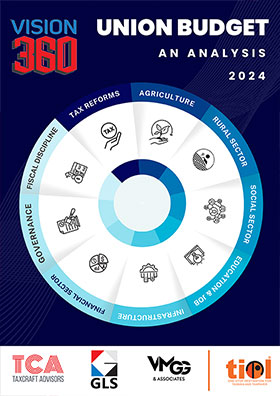Credit on outward transportation - clarification to put an end to futile litigation
FEBRUARY 24, 2016
By Bimal Jain, FCA, FCS, LLB, B.Com (Hons)
 THE manufacturers receive the services of Goods Transportation Agency ("GTA") for outward transportation of the final products from their factory to customer's/dealer's premises. Availability of Cenvat credit of Service tax paid on outward transportation of goods from factory to the customer's premise has been a tale of endless negotiations and litigation.
THE manufacturers receive the services of Goods Transportation Agency ("GTA") for outward transportation of the final products from their factory to customer's/dealer's premises. Availability of Cenvat credit of Service tax paid on outward transportation of goods from factory to the customer's premise has been a tale of endless negotiations and litigation.
Meaning of the term 'input service'
Prior to April 1, 2008, erstwhile definition of input service under Rule 2(l) of the Cenvat Credit Rules, 2004 ("the Credit Rules"), contained two different clauses in the definition of input service, with one including any service used for clearance of final products from the place of removal and other restricting outward transportation up to the place of removal, which created all the debate and confusion.
However, w.e.f April 1, 2008, it is crystal clear that Rule 2(l) of the Credit Rules permits Cenvat credit of Service tax paid on the services availed by the manufacturer for clearance of final products but only 'up to' the 'place of removal'. Rule 2(l) of the Credit Rules, at present, reads as follows:
"2(l) "input service" means any service, -
(i) used by a provider of output service for providing an output service; or
(ii) used by the manufacturer, whether directly or indirectly, in or in relation to the manufacture of final products and clearance of final products upto the place of removal.
and includes services used in relation to modernization, renovation or repairs of a factory, premises of provider of output service or an office relating to such factory or premises, advertisement or sales promotion, market research, storage upto the place of removal, procurement of inputs, accounting, auditing, financing, recruitment and quality control, coaching and training, computer networking, credit rating, share registry, security, business exhibition, legal services, inward transportation of inputs or capital goods and outward transportation upto the place of removal;
………………."
(Emphasis Supplied)
Thus, the meaning and extent of the term 'place of removal' plays vital and pivotal & centric role in order to determine eligibility to avail Cenvat credit on outward transportation services.
Meaning of the term 'place of removal'
Prior to July 11, 2014, the term, 'place of removal' was interpreted as per the definition provided under Section 4(3)(c) of the Central Excise Act, 1944 ("the Excise Act") read with Rule 2(t) of the Credit Rules. Section 4(3)(c) of the Excise Act provides the definition of 'place of removal' as under:
"c. "place of removal" means-
i. a factory or any other place or premises of production or manufacture of the excisable goods;
ii. a warehouse or any other place or premises wherein the excisable goods have been permitted to be deposited without payment of duty,
iii. a depot, premises of a consignment agent or any other place or premises from where excisable goods are to be sold after their clearance from the factory.
from where such goods are removed;"
Thus, in view of the above discussed provisions, it can be inferred that the place of removal can be factory or any other place or depot, premises of consignment agent or any other place or premises from where the excisable goods are to be sold, which clearly includes customer's/dealer's premises or depot from where the excisable goods are sold.
Accordingly, Cenvat credit should be available of the amount of Service tax paid on the GTA services availed for transportation of goods from factory to the customer's premises.
Master Circular 97/8/2007-ST dated August 23, 2007 ("the Master Circular"): Customer's premises is the 'place of removal' in case of FOR sales
The aforesaid discussed inference of the term 'place of removal' was fortified with the CBEC stepping in and issuing the Master Circular allowing Cenvat credit on outward transportation in case of FOR sales vide Para 8.2 thereof, which effectively equated the customer's premises as a 'place of removal' in case of FOR sales. As per the Master Circular, the Cenvat credit in respect of outward transportation from factory gate/ depots to customer's premises would be eligible if sales are made on FOR destination basis i.e. subject to fulfilment of following three conditions:
(i) ownership of goods and the property in the goods remained with the seller of the goods till the delivery of the goods in acceptable condition to the purchaser at his door step;
(ii) the seller bore the risk of loss of or damage to the goods during transit to the destination; and
(iii) the freight charges were an integral part of the price of goods i.e. Freight is not charged separately
Relying upon the Master Circular, in gamut of judgments Cenvat credit on outward transportation was allowed. Few of such cases are:
Palco Metals Ltd. Vs. Commissioner of C. Ex., Ahmedabad - 2011-TIOL-1990-CESTAT-AHM;
Orchev Pharma P. Ltd. Vs. Commissioner of Central Excise, Rajkot - 2014-TIOL-120-CESTAT-AHM;
Rohit Surfactant Pvt. Ltd. Vs. Commissioner of C. Ex., Jaipur-I - 2011-TIOL-1780-CESTAT-DEL;
Divergent Judgments passed by the Hon'ble CESTAT in few cases - Opening up the debate on applicability of Section 4(3)(c) of the Excise Act when duty is chargeable at specific rates
In the interim, few contrary judgments of the Hon'ble Tribunal [Ultratech Cement Ltd. Vs. Commissioner of C. Ex., Raipur - 2014-TIOL-478-CESTAT-DEL kindled the issue of applicability of definition of 'place of removal' given under Section 4(3)(c) of the Excise Act, when valuation is not done in accordance with Section 4 thereof.
Presuming factory gate as 'place of removal' when Excise duty is charged on specific rate is incorrect - Hon'ble High Court of Chhattisgarh
On appeal being filed to the Hon'ble High Court of Chhattisgarh, the Hon'ble High Court in the case of Ultra Tech Cement Ltd. Vs. CCE, Raipur - 2014-TIOL-1437-HC-Chattisgarh-CX, relying upon its judgment in the case of Lafarge India Ltd. Vs. CCE, Raipur [Tax Case- 34 of 2011], clearly held that presumption by the Hon'ble Tribunal that 'place of removal' is factory gate of the manufacturer in case the Excise duty is charged on the specified rate is incorrect.
Insertion of new sub-rule (qa) in Rule 2 of the Credit Rules, introducing definition of 'place of removal' in the Credit Rules itself - Puts rest to controversies of buyer's premises being the place of removal when Excise duty is charged at specific rate
Effective from July 11, 2014, the Credit Rules has been amended vide Notification No. 21/2014-Central Excise (N.T.) dated July 11, 2014 (Effective from July 11, 2014) whereby a new sub-rule (qa) has been inserted in Rule 2 of the Credit Rules to introduce the definition of 'place of removal' in the Credit Rules itself, which is parimateria or similar in definition as provided under Section 4(3)(c) of the Excise Act (supra),putting rest to controversies of buyer's premises being the place of removal when Excise duty is charged at specific rate.
CBEC's Circular No. 988/12/2014-CX dated October 20, 2014: P lace, where property in goods passes from the seller to the buyer is the relevant consideration to determine the 'place of removal'
Further, the CBEC vide Circular No. 988/12/2014-CX dated October 20, 2014 again clarified that 'the place where property in goods passes on to the buyer' is relevant to determine 'place of removal'.
Recent judgment of the Supreme Court in Ispat Case, adding another round of discussions on interpretation of 'place of removal'
Recently, the Hon'ble Supreme Court in the case of Commissioner of Cus. & C. Ex., Nagpur Vs. Ispat Industries Ltd. - 2015-TIOL-238-SC-CX, has held that place of removal can only be the manufacturers' premises because the words used in Section 4(3)(c) of the Excise Act states 'are to be sold'.Thus, such place, where goods are to be sold can never be buyers premises even if sale takes place at the buyers premises, because it is a place where goods have been sold and not where goods are to be sold.
Even though, the judgment deals with the valuation issue wherein prices charged were "ex-works", i.e. goods were cleared from the factory on payment of the appropriate Sales tax by the assessee itself, thereby indicating that it had sold the goods manufactured by it at the factory gate itself, but the stated judgment has again started the discussions on meaning and extent of the term 'place of removal' which plays an important role for availment of Cenvat credit also.
Suitable direction/clarification required to allow Cenvat credit on outward transportation, when sales are made on FOR basis, to put an end to the tale of endless futile litigation
Although insertion of new sub-rule (qa) in Rule 2 of the Credit Rules to introduce the definition of 'place of removal' in the Credit Rules itself (effective from July 11, 2014) and the recent clarification of the CBEC, are clearly providing for admissibility of Cenvat credit on GTA services procured for transportation of goods till customer's premises in case of FOR sales, but, the field formation at certain Commissionerates are raising unwanted show cause notices on non-admissibility of Cenvat credit on outward transportation on the ground of it being availed beyond the place of removal.
Therefore, a suitable direction/clarification in this regard can help to bring an end to futile litigations again and again, save the time, money and efforts of the Country, its Department and the Trade & Industry.
|
(DISCLAIMER : The views expressed are strictly of the author and Taxindiaonline.com doesn't necessarily subscribe to the same. Taxindiaonline.com Pvt. Ltd. is not responsible or liable for any loss or damage caused to anyone due to any interpretation, error, omission in the articles being hosted on the sites)
|









 THE manufacturers receive the services of Goods Transportation Agency ("GTA") for outward transportation of the final products from their factory to customer's/dealer's premises. Availability of Cenvat credit of Service tax paid on outward transportation of goods from factory to the customer's premise has been a tale of endless negotiations and litigation.
THE manufacturers receive the services of Goods Transportation Agency ("GTA") for outward transportation of the final products from their factory to customer's/dealer's premises. Availability of Cenvat credit of Service tax paid on outward transportation of goods from factory to the customer's premise has been a tale of endless negotiations and litigation. 





